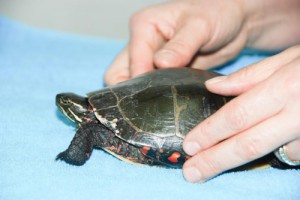LITTLE CURRENT—A painted turtle seemingly asking for help after having its shell chewed by a dog in Little Current was whisked to the safety of the Island Animal Hospital last week, the first step on its road to recovery.
Dr. Mary Yett, proprietor of the Island Animal Hospital, contacted The Expositor last week, sharing the news of the rescued female, discovered pregnant with 10 eggs after an x-ray at the veterinary office. Peter Gandhi, the new owner of the Hawberry Motel located on a busy stretch of Highway 6 in Little Current, explained that while on his nighttime rounds, just before closing, he discovered the turtle at his front door.
“I saw it was bleeding from the top so I brought it inside and put it in some water,” Mr. Gandhi explained. “I then went online to see what kind of food it eats.”
After a little more Internet research, he discovered the Island Animal Hospital in Mindemoya and phoned in his discovery the following morning. He admitted that after learning of the costs this turtle would incur, thoughts of simply releasing the turtle into the water crossed his mind, “But the doctor told me that its wound might become infected, so I drove to Mindemoya.”
When learning about the rescued turtle’s pregnancy, Mr. Gandhi replied, “I said, ‘holy!’ That’s why I’m getting such good karma. My motel was full for three days afterwards. I know that turtles are lucky in some cultures.”
Part of the turtle’s shell has been chewed away and the obvious puncture marks from canine teeth looked raw. Dr. Yett said the wounds were indicative of a fresh attack.
“An infection from the wounds would have set in and would have eventually killed the turtle,” Dr. Yett explained. “We contacted the Kawartha Turtle Trauma Centre and gave her pain medication, antibiotics and fluids (turtle triage). After one day she was obviously feeling better.”
The veterinarian was headed for Port Severn last weekend and through the turtle taxi network, was met there by a volunteer who relayed the little animal on to deliver her to Peterborough. The Trauma Centre relies on over 60 volunteers from across Ontario to bring the injured reptiles to Peterborough.
“Her odds of a full recovery are excellent,” Dr. Yett said.
Kate Siena is the delivery and sustainability coordinator with the Trauma Centre, who noted, “We’re the only turtle hospital in Ontario.”
“There are eight species in Ontario, seven of which are species at risk,” Ms. Siena explained. “Every spring turtles go walkabout, leaving the water to walk kilometers to lay their eggs.”
Most of the turtles the Trauma Centre sees are hit by cars, she added, noting that the hospital dealt with 664 emergencies last year. The centre fills two main roles, Ms. Siena continued, providing medical care and educating the public.
She said that painted turtles will sometimes see the same kind of trauma as the current patient (named No. 73) because of their size.
If a turtle is pregnant when it comes into the centre, as is No. 73, stable patients will receive nesting boxes while turtles facing a harder road to recovery will be induced into labour, their eggs incubated. The Manitoulin patient has been deemed well enough to receive a nesting box, and her eggs will be incubated and the hatchlings will eventually be released after a year’s time, in Little Current. The mother too will be released to the Little Current area once she is healthy—the turtle taxi network once again coming into play.
Ms. Siena praised Dr. Yett for her enthusiasm with getting the turtle to the centre and her stabilizing work with turtle triage.
When asked for advice on the moving of turtles from roadways, Ms. Siena said, “If it’s safe for you to do so, move them in the direction that they’re going, even if they’re moving away from water.”
“For snapping turtles, if you can get them to snap onto a branch and then move them, or get them onto a car floor mat and drag them across the road,” she continued. “Most turtles hide (pull their appendages inside their shell) when they’re scared, but snapping turtles can’t do this and that’s why they snap. They often receive facial trauma from jumping at tires passing by them, so if you can, give them a wide berth on the road.”




